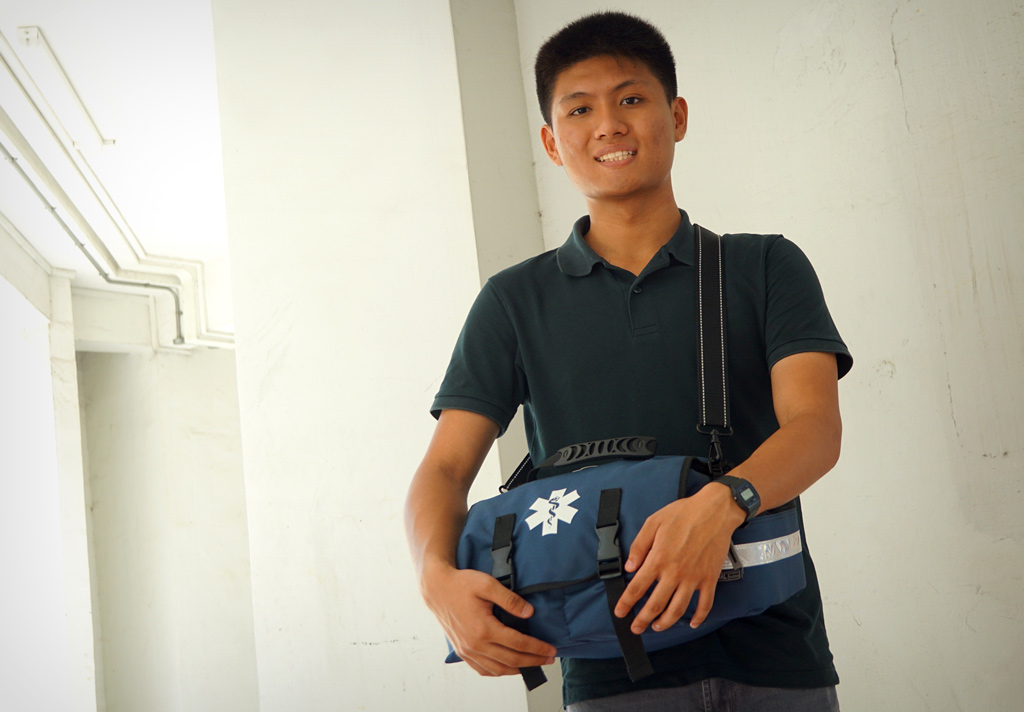Meet the man using myResponder to save lives
TL;DR: In the event of a medical emergency, community first responders can provide crucial assistance to patients and their families before paramedics arrive. TechNews spoke to nursing student Mr Rex Ang Jia Jie to find out how he uses the SCDF’s myResponder app to put his lifesaving skills to good use.
Like a nail to a magnet, Mr Rex Ang Jia Jie rushes to the scene of a medical emergency with his trauma bag each time a siren sounds on his mobile phone. He usually makes it to the patient before an ambulance does, and drawing on his training in first aid and basic cardiac life support, he helps to stabilise the individual and perform cardiopulmonary resuscitation (CPR) if necessary.
But Mr Ang isn’t a paramedic with the Singapore Civil Defence Force (SCDF). In fact, the 20-year-old has not even gone for national service; he is currently pursuing a diploma in nursing at Parkway College of Nursing and Allied Health and will only be enlisted in 2021. In the meantime, he is already saving lives in a personal capacity—as a community first responder (CFR).
“I’ve always felt a calling to help others, and I thought the best way to contribute was to start getting myself certified in standard first aid, the use of an automated external defibrillator (AED) and basic cardiac life support,” said Mr Ang. He bore the cost of training himself, noting that it was “well worth it”—his knowledge and skills have come in handy more than 20 times now since he downloaded the myResponder mobile app on his smartphone in January 2017.
Building a community of good Samaritans
Developed by the SCDF in collaboration with the Government Technology Agency of Singapore (GovTech), myResponder is a means to crowdsource for lifesavers. Whenever the SCDF is notified of a medical emergency and assesses it to be a case of cardiac arrest, it sends out a message to CFRs registered on the app who are within 400 metres of the patient.
Every second counts when the heart stops beating, so CFRs like Mr Ang make a huge difference by rendering immediate help. “Most of the time, when I’m activated by myResponder, I will need to perform CPR,” Mr Ang recounted. In doing so, he increases a cardiac arrest patient’s chances of survival by two to three times.
Today, there are more than 40,000 CFRs like Mr Ang registered on myResponder, augmenting the capabilities of the SCDF. Mr Ang highlights some features of the app that he finds immensely useful:
-
Easy registration
Anyone interested in becoming a CFR can simply sign in to the app using their SingPass, which makes it convenient for them to input their contact details and personal particulars. This is important to ensure that notifications from the app will be sent to an active device.
Thereafter, “you’ll be guided through a short tutorial and asked to indicate whether you are trained in first aid, CPR or AED,” said Mr Ang. And with that, you’re all set and good to go!
-
Constant GPS updates
You can’t save a life if you have trouble finding your way to the location of a person who has suffered a cardiac arrest. Hence, constant GPS updates, coupled with an address revealed only to the CFR who accepts the call for help, allow lifesavers to navigate quickly to where they are needed.
-
Map of all nearby AEDs
In the event of a cardiac arrest, an AED may be required to deliver a shock to the heart to kickstart its rhythm once more. Not everyone owns an AED, so the SCDF has partnered with the Singapore Heart Foundation to develop a national AED registry for publicly accessible AEDs.
“The myResponder app has a map of all the AEDs in your vicinity. You can probably find one every two blocks. I always look for the nearest AED when I respond to a cardiac arrest case,” said Mr Ang.
-
After-action review
Mr Ang also noted that the app allows CFRs to submit a brief report on what happened prior to the arrival of an emergency medical team. The default report comes in a simple yes-or-no format: Did you arrive before the SCDF? Did you perform CPR? Was an AED used?
There’s also an optional, open-ended field for additional details to be filled up. For Mr Ang, he includes information such as the patient’s heart rate, blood pressure and blood oxygenation level, obtained using the equipment in his trauma bag. Where possible, he even keys in a brief medical history of the patient provided by the patient’s family members. All this information can help medical professionals make better decisions later on.
-
Alerts on minor fires
Rubbish chute fires account for approximately 50 percent of fires in residential estates, and some of these minor blazes do not need to be dealt with by a fire truck. CFRs that are in the area can help to put out these small fires and take geo-tagged photos of the extent of the damage.
“You can capture an overview of the scene, highlight points of interest and even send the SCDF a video of the incident,” Mr Ang explained, adding that this serves as real-time feedback to the SCDF so that additional firefighting resources can be dispatched if necessary.
At the end of the day, myResponder is but software; it is the actions of people like Mr Ang who truly change the outcome of life-and-death situations, a fact deeply appreciated by the SCDF. To date, Mr Ang has received five commendations from the SCDF for administering CPR to cardiac arrest patients.
“I just feel very satisfied being able to help people. Watching them recover reinforces the fact that I made the right choice to join nursing as a profession,” he said.
https://www.tech.gov.sg/media/technews/meet-the-man-using-myResponder-to-save-lives


